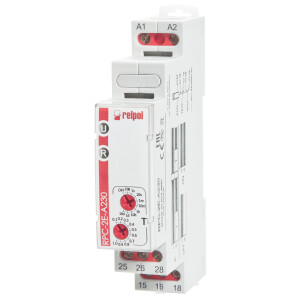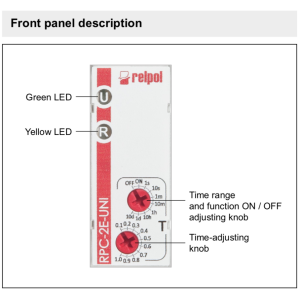Time Relays
| Quantity | Single price |
|---|---|
| 1 | 25,26 €* |
| 10 | 23,24 €* |
| 20 | 20,92 €* |
- Must be ordered. Ready for shipment in 17 days after order.
-
Delivery time: 19 - 21 Workdays (Other countries)
| Quantity | Single price |
|---|---|
| 1 | 30,35 €* |
| 10 | 27,92 €* |
| 20 | 25,12 €* |
- 9 pcs. In stock
-
Delivery time: 2 - 4 Workdays (Other countries)
| Quantity | Single price |
|---|---|
| 1 | 25,49 €* |
| 10 | 23,44 €* |
| 20 | 21,10 €* |
- 7 pcs. In stock
-
Delivery time: 2 - 4 Workdays (Other countries)
| Quantity | Single price |
|---|---|
| 1 | 24,67 €* |
| 10 | 22,69 €* |
| 20 | 20,43 €* |
- 21 pcs. In stock
-
Delivery time: 2 - 4 Workdays (Other countries)
| Quantity | Single price |
|---|---|
| 1 | 25,13 €* |
| 10 | 23,12 €* |
| 20 | 20,80 €* |
- 19 pcs. In stock
-
Delivery time: 2 - 4 Workdays (Other countries)
| Quantity | Single price |
|---|---|
| 1 | 25,49 €* |
| 10 | 23,44 €* |
| 20 | 21,10 €* |
- 86 pcs. In stock
-
Delivery time: 2 - 4 Workdays (Other countries)
| Quantity | Single price |
|---|---|
| 1 | 25,13 €* |
| 10 | 23,12 €* |
| 20 | 20,80 €* |
- 6 pcs. In stock
-
Delivery time: 2 - 4 Workdays (Other countries)
| Quantity | Single price |
|---|---|
| 1 | 24,91 €* |
| 10 | 22,92 €* |
| 20 | 20,62 €* |
- 9 pcs. In stock
-
Delivery time: 2 - 4 Workdays (Other countries)
| Quantity | Single price |
|---|---|
| 1 | 52,62 €* |
| 2 | 48,41 €* |
| 5 | 43,57 €* |
- Must be ordered. Ready for shipment in 8 days after order.
-
Delivery time: 10 - 12 Workdays (Other countries)
| Quantity | Single price |
|---|---|
| 1 | 24,67 €* |
| 10 | 22,69 €* |
| 20 | 20,43 €* |
- Must be ordered. Ready for shipment in 16 days after order.
-
Delivery time: 18 - 20 Workdays (Other countries)
| Quantity | Single price |
|---|---|
| 1 | 24,67 €* |
| 10 | 22,69 €* |
| 20 | 20,43 €* |
- 20 pcs. In stock
-
Delivery time: 2 - 4 Workdays (Other countries)
| Quantity | Single price |
|---|---|
| 1 | 24,67 €* |
| 10 | 22,69 €* |
| 20 | 20,43 €* |
- 6 pcs. In stock
-
Delivery time: 2 - 4 Workdays (Other countries)
| Quantity | Single price |
|---|---|
| 1 | 38,59 €* |
| 10 | 35,51 €* |
| 20 | 31,95 €* |
- 24 pcs. In stock
-
Delivery time: 2 - 4 Workdays (Other countries)
| Quantity | Single price |
|---|---|
| 1 | 25,61 €* |
| 10 | 23,56 €* |
| 20 | 21,21 €* |
- 5 pcs. In stock
-
Delivery time: 2 - 4 Workdays (Other countries)
| Quantity | Single price |
|---|---|
| 1 | 24,31 €* |
| 10 | 22,37 €* |
| 20 | 20,13 €* |
- 4 pcs. In stock
-
Delivery time: 2 - 4 Workdays (Other countries)
| Quantity | Single price |
|---|---|
| 1 | 24,67 €* |
| 10 | 22,69 €* |
| 20 | 20,43 €* |
- Must be ordered. Ready for shipment in 7 days after order.
-
Delivery time: 11 - 13 Workdays (Other countries)
| Quantity | Single price |
|---|---|
| 1 | 71,34 €* |
| 10 | 64,21 €* |
| 20 | 60,64 €* |
- Must be ordered. Ready for shipment in 112 days after order.
-
Delivery time: 114 - 116 Workdays (Other countries)
| Quantity | Single price |
|---|---|
| 1 | 24,67 €* |
| 10 | 22,69 €* |
| 20 | 20,43 €* |
- 9 pcs. In stock
-
Delivery time: 4 - 6 Workdays (Other countries)
| Quantity | Single price |
|---|---|
| 1 | 24,67 €* |
| 10 | 22,69 €* |
| 20 | 20,43 €* |
- Must be ordered. Ready for shipment in 5 days after order.
-
Delivery time: 9 - 11 Workdays (Other countries)
| Quantity | Single price |
|---|---|
| 1 | 24,67 €* |
| 10 | 22,69 €* |
| 20 | 20,43 €* |
- Must be ordered. Ready for shipment in 5 days after order.
-
Delivery time: 9 - 11 Workdays (Other countries)
What functional types of time relays are there?
The respective type of time relay includes specific functions and was developed for different areas of application. We have listed the most important types of time relays in the overview below.- As soon as voltage is applied to a relay with on-delay, the time delay begins and the process is initiated after the time delay has elapsed. Relays with a switch-on delay are used, for example, in burglar alarms. Here, a switch-on delay relay ensures that authorized persons have sufficient time to deactivate the security system before the alarm is activated.
- The time measurement of the off-delay relay starts after voltage is applied and switches off the process after the time period has elapsed. Time relays with a switch-off delay are used in stairwells. After someone climbs up or down the stairs and presses the switch, the light stays on for a few seconds before turning off. This allows enough time to safely exit the stairs.
- Single-shot timer or one-shot timer relay reacts only once to the trigger and initiates the action after the time period has elapsed. One-shot timer relays are used in industrial automation on production lines. They ensure that only a single assembly operation takes place after each triggered test process. The assembly is activated once after receiving the start signal and then stops until a new start signal is sent.
- Turn signal timer relays specialize in periodically turning on and off or flashing, such as lights or indicator lamps. In a vehicle turn signal, you activate and deactivate the direction indicator at the desired interval. In emergency lighting systems, turn signal timer relays flash the light at regular intervals, indicating that the system is functioning properly.
- Interval-on time relays or relays with a repeat cycle describe relays that switch on and off at regular intervals or execute a repeated cycle. In a heating system, an interval-on time relay can enable efficient heat distribution and temperature control. By activating and deactivating the boiler at regular intervals, it maintains the desired room temperature while optimizing energy consumption. Unlike the turn signal timer relay, a repeat cycle relay performs switching cycles continuously and is used in a wider range of applications.
- Multifunction time relays provide various timing functions in a single device. For example, they can include delay, pulse, cycle repetition and more. Its advantage lies in its versatility and the ability to combine different time functions in one application.
What should you consider when buying a time relay?
Before purchasing a time relay, requirements such as the time range, type of relay, power supply, mounting options and size must be taken into account.Selecting a suitable time relay in 4 steps:
- 1. First determine the required time range and delay time for your application. Depending on whether you need milliseconds or hours, this can have a decisive influence on your choice of time relay.
- 2. Next, you should select the appropriate type of time relay for your application. This depends on the desired accuracy, switching cycles and environmental conditions. Some time relays offer different operating modes such as delay, pulse or cycle repetition.
- 3. Check the time relay voltage requirements and ensure they are compatible with your existing power supply. We provide you with time relays and multi-function relays in the voltages 12V, 24V, 230V, with 1, 2, or 3 contacts.
- 4. Consider the available space and mounting options in your application. This way you can be sure that the time relay physically meets the requirements.
Relays in general are electrical switching devices that are used to open or close a circuit. They react to a control signal and then carry out an action. Time relays are specialized to trip after a set time interval. They enable precise control of processes without human intervention and help increase efficiency. Users can set the time intervals individually.
Time relays have adjustable time delays and are based on various technologies. For example, a distinction is made between electromechanical, electronic and solid-state time relays. Electromechanical time relays use mechanical components such as springs and levers to perform the delay function. They are robust and reliable and are particularly suitable for applications in harsh environments. Electronic time relays use microcontroller technology to provide precise time delays. They are flexible, offer a wide range of setting options and are ideal for applications requiring the highest levels of accuracy. Solid-state time relays use semiconductor components instead of mechanical parts. They are maintenance-free, fast and offer precise time control. Their advantage lies in reliability and the ability to handle frequent switching cycles.
Time relays are used in many different areas of application, such as industry, building automation or traffic control. In the industrial sector they are used to automatically switch off machines after a set period of time or to control production processes. Time delay relays can control the lighting of buildings and regulate the operating times of heating, ventilation and air conditioning systems. In household appliances, such as washing machines or dishwashers, they ensure that the programs start and stop on time.
The different types of timer relays include: on-delay relays, off-delay relays, one-shot timer relays, repeat cycle timer relays and flasher timer relays. Each species has specific areas of application and functions.
A relay is an electrical switching device that opens or closes electrical contacts when a control signal is applied. A time relay is a special type of relay that specializes in time delays.
The most commonly used time relay is the on-delay time relay. For example, it allows a power-on delay to ensure that a process completes before another process starts.
A time relay can consist of electromechanical or electronic components. Electromechanical time relays often have timers, relays and contacts. Electronic time relays, on the other hand, use semiconductor components such as transistors and integrated circuits to control the time delays. The exact structure may vary depending on the model.
Trigger signals can consist of voltage inputs, button presses, sensor signals (such as motion sensors or light sensors), timing controls, digital signals, or temperature or pressure limits.
Setting a time relay depends on the specific type and model. As a rule, the setting is done by turning timers, adjusting potentiometers or programming electronic time relays using control buttons or software.



















































